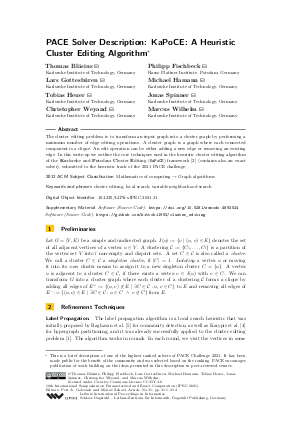PACE Solver Description: KaPoCE: A Heuristic Cluster Editing Algorithm
Authors Thomas Bläsius, Philipp Fischbeck, Lars Gottesbüren, Michael Hamann, Tobias Heuer, Jonas Spinner, Christopher Weyand, Marcus Wilhelm
-
Part of:
Volume:
16th International Symposium on Parameterized and Exact Computation (IPEC 2021)
Part of: Series: Leibniz International Proceedings in Informatics (LIPIcs)
Part of: Conference: International Symposium on Parameterized and Exact Computation (IPEC) - License:
 Creative Commons Attribution 4.0 International license
Creative Commons Attribution 4.0 International license
- Publication Date: 2021-11-22
File

PDF
LIPIcs.IPEC.2021.31.pdf
- Filesize: 439 kB
- 4 pages
Document Identifiers
Subject Classification
ACM Subject Classification
- Mathematics of computing → Graph algorithms
Keywords
- cluster editing
- local search
- variable neighborhood search
Metrics
- Access Statistics
-
Total Accesses (updated on a weekly basis)
0PDF Downloads0Metadata Views
Abstract
The cluster editing problem is to transform an input graph into a cluster graph by performing a minimum number of edge editing operations. A cluster graph is a graph where each connected component is a clique. An edit operation can be either adding a new edge or removing an existing edge. In this write-up we outline the core techniques used in the heuristic cluster editing algorithm of the Karlsruhe and Potsdam Cluster Editing (KaPoCE) framework, submitted to the heuristic track of the 2021 PACE challenge.
Cite As Get BibTex
Thomas Bläsius, Philipp Fischbeck, Lars Gottesbüren, Michael Hamann, Tobias Heuer, Jonas Spinner, Christopher Weyand, and Marcus Wilhelm. PACE Solver Description: KaPoCE: A Heuristic Cluster Editing Algorithm. In 16th International Symposium on Parameterized and Exact Computation (IPEC 2021). Leibniz International Proceedings in Informatics (LIPIcs), Volume 214, pp. 31:1-31:4, Schloss Dagstuhl – Leibniz-Zentrum für Informatik (2021)
https://doi.org/10.4230/LIPIcs.IPEC.2021.31
BibTex
@InProceedings{blasius_et_al:LIPIcs.IPEC.2021.31,
author = {Bl\"{a}sius, Thomas and Fischbeck, Philipp and Gottesb\"{u}ren, Lars and Hamann, Michael and Heuer, Tobias and Spinner, Jonas and Weyand, Christopher and Wilhelm, Marcus},
title = {{PACE Solver Description: KaPoCE: A Heuristic Cluster Editing Algorithm}},
booktitle = {16th International Symposium on Parameterized and Exact Computation (IPEC 2021)},
pages = {31:1--31:4},
series = {Leibniz International Proceedings in Informatics (LIPIcs)},
ISBN = {978-3-95977-216-7},
ISSN = {1868-8969},
year = {2021},
volume = {214},
editor = {Golovach, Petr A. and Zehavi, Meirav},
publisher = {Schloss Dagstuhl -- Leibniz-Zentrum f{\"u}r Informatik},
address = {Dagstuhl, Germany},
URL = {https://drops.dagstuhl.de/entities/document/10.4230/LIPIcs.IPEC.2021.31},
URN = {urn:nbn:de:0030-drops-154147},
doi = {10.4230/LIPIcs.IPEC.2021.31},
annote = {Keywords: cluster editing, local search, variable neighborhood search}
}
Author Details
Supplementary Materials
- Software (Source Code) https://doi.org/10.5281/zenodo.4892524
- Software (Source Code) https://github.com/kittobi1992/cluster_editing
References
-
Lucas Bastos, Luiz Satoru Ochi, Fábio Protti, Anand Subramanian, Ivan César Martins, and Rian Gabriel S Pinheiro. Efficient Algorithms for Cluster Editing. Journal of Combinatorial Optimization, 31(1):347-371, 2016.

- Thomas Bläsius, Philipp Fischbeck, Lars Gottesbüren, Michael Hamann, Tobias Heuer, Jonas Spinner, Christopher Weyand, and Marcus Wilhelm. KaPoCE - An Exact and Heuristic Solver for the Cluster Editing Problem. https://github.com/kittobi1992/cluster_editing/tree/pace-2021, 2021. URL: https://doi.org/10.5281/zenodo.4892524.
-
Pierre Hansen and Nenad Mladenović. Variable Neighborhood Search. In Handbook of Metaheuristics, pages 145-184. Springer, 2003.

-
George Karypis and Vipin Kumar. Multilevel k-way Hypergraph Partitioning. Technical Report 98-036, University of Minnesota, 1998.

-
Usha Nandini Raghavan, Réka Albert, and Soundar Kumara. Near Linear Time Algorithm to Detect Community Structures in Large-Scale Networks. Physical Review E, 76(3):036106, 2007.

